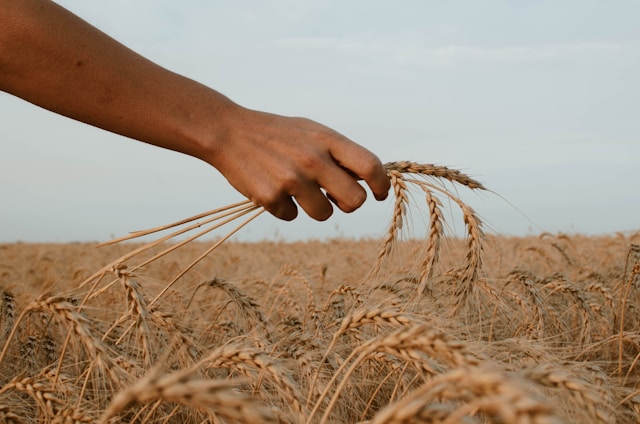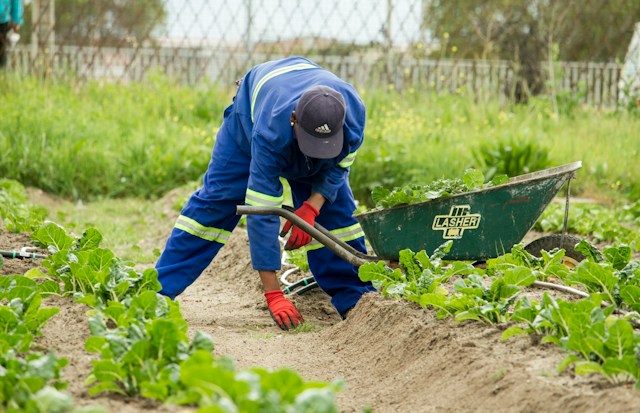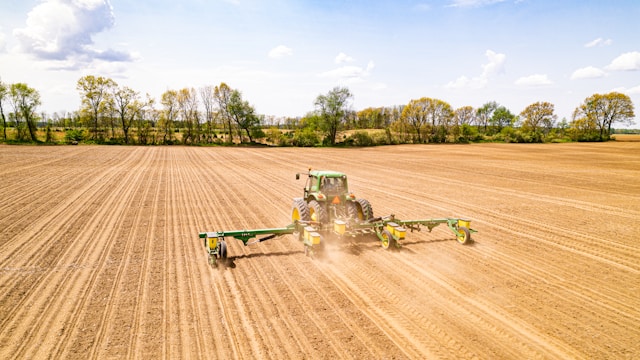In the universe of farming, maximizing crop yield is a primary objective.
To achieve this goal, various strategies are utilized; among the most effective is crop rotation.
This method not only enhances soil fertility but also aids in managing pests and diseases.
Despite its proven benefits, mastering the art of crop rotation demands comprehensive knowledge and understanding.
This article will delve into different effective rotation systems, their benefits, and how to properly implement them.
Implementing these strategies on your farm can significantly boost production and, ultimately, profitability.
Contents
- Crop Rotation Strategies For Optimal Yield
- 1. Rotate between legumes and non-legumes
- 2. Incorporate cover crops during off-seasons.
- 3. Always Allow a Fallow (Rest) Period
- 4. Combine Deep-Rooted and Shallow-Rooted Plants
- 5. Rotate pest-prone crops yearly
- 6. Use disease-resistant crop varieties.
- 7. Integrate livestock into rotation plan.
- 8. Use Soil Nutrient Testing Regularly
- 9. Use Organic Matter Like Compost
- 10. Rotate High-Residue and Low-Residue Crops
- The Bottom Line
Crop Rotation Strategies For Optimal Yield
1. Rotate between legumes and non-legumes
One key strategy under the umbrella of crop rotation involves the rotation between leguminous and non-leguminous crops.
This method actively seeks to balance the nutrition of the soil and maintain soil health over multiple growing seasons.
The overarching principle behind this strategy is the use of legumes’ ability to fix nitrogen naturally and infuse it back into the soil.
Non-leguminous crops cannot do this and often deplete the soil’s nitrogen content.
When legumes are grown, they actively fix atmospheric nitrogen into the soil, effectively replenishing the nutrient content for the next-depleting, non-legume crop.
This rotation is considered sustainable and reduces the need for synthetic fertilizers, making it an important strategy for organic farming.
The nature of the crops being traded off – legumes for non-legumes – is important because different crops have different nutrient needs and leave different residues in the soil.
Switching between different types of plants helps prevent the build-up of diseases that can become endemic to a monocropped field.
Moreover, legumes and non-legumes have varied root system depths which allow improved utilization and exploration of the soil profile.
Legumes with their deeper roots can retrieve water and nutrients from deeper soil profiles, increasing overall yield and efficiency.
On the other hand, non-legumes with shallower root systems help in maintaining soil structure, controlling erosion, and reducing nutrient leaching.
Having this continual shift between crop types reduces the risk of single-crop diseases and pest infestations, crucial for long-term yields and soil vitality.
An added benefit of this rotation strategy is that it often enhances overall soil structure and fertility and reduces erosion.
The organic matter from the crops, particularly from the legumes, improves soil’s physical properties, increasing its capacity to retain water, resist compaction, and maintain porosity.
Thus, by rotating between legumes and non-legumes, you prepare the soil for better plant growth, improving crop yield and farm profitability.
Adopting such a crop rotation strategy provides a comprehensive solution to the compelling issues faced in modern-day farming such as disease management, soil fertility depletion, and the adverse effects of chemical over-reliance.
2. Incorporate cover crops during off-seasons.
One essential strategy for successful crop rotation is the incorporation of cover crops during off-seasons.
Cover crops are a unique type of crop planted primarily to manage soil quality, fertility, water, pests, diseases, and biodiversity in an agroecosystem.
Given their role, cover crops can provide numerous benefits when integrated into a crop rotation plan.
They reduce soil erosion, which often occurs during off-season periods when the soil is bare.
Moreover, cover crops improve the soil structure by producing a large amount of biomass that adds organic matter to the soil.
This means that the soil’s water-holding capacity gets better, promoting better growth and development of future crops.
They also suppress weed growth, as they can outcompete weeds for resources.
By doing this, they reduce the amount of manual labor and cost needed for weed control.
Frequently, cover crops are able to fix nitrogen from the atmosphere, providing a natural fertilizer for following crops.
Examples of these are leguminous cover crops like cowpeas, clover, and vetch that contain specific bacteria in their root nodules that fix atmospheric nitrogen.
When these plants decompose, they release this nitrogen, supplying available nutrients for succeeding crops and reducing the need for synthetic fertilizers.
The process of nitrogen fixation by cover crops contributes to nutrient cycling, a vital part of crop rotation strategies.
Finally, cover crops, especially those that are not hosts for diseases and pests that plague the main crops, can break the lifecycle of these harmful organisms.
Consequently, they minimize disease and pest incidences in the following season.
In conclusion, the inclusion of cover crops in a crop rotation plan during off-seasons not only protects the soil but also prepares it for planting the next crop.
Thus, to optimize yield, a well-planned and properly managed system of crop rotation should include the use of cover crops during the off-season periods.
3. Always Allow a Fallow (Rest) Period
The concept of a fallow period, a time during which agricultural land is left uncultivated, is crucial to crop rotation strategies.
Typically, this rest period is provided to allow the soil to recover after a farming season, enhancing its fertility for the subsequent growing period.
Fallowing is considered one of the traditional methods of farming which has withstood the test of time, demonstrating its effectiveness consistently.
During the fallow period, natural processes take place that help rebuild and replenish soil nutrients.
>Crucially, the fallow period can reduce the risks of the buildup of soil-borne diseases and pests, contributing to overall plant health in the long run.
Not only does it contribute to pest control, but it also decreases the weed pressure by disrupting the lifecycles of annual and perennial weeds.
When fields lie fallow, earthworms and other beneficial soil organisms have an opportunity to proliferate, enhancing the soil structure and nutrient content.
Moreover, fallow seasons can provide a chance to control soil erosion by growing cover crops.
Fallowing, however, should not be prolonged excessively as it can lead to soil degradation due to erosion and nutrient leaching.
An ideal time for a fallow period depends on the soil condition and crop type.
Typically, the fallow period may last for one or two seasons, but should be adjusted based on individual field conditions.
It’s also important to recognize the potential financial implications of a fallow period, and to plan accordingly.
While finances can seem tight during this period, the long-term payoff can often justify the short-term expense.
Therefore, including a fallow period in a crop rotation strategy is a sustainable agricultural practice benefitting long-term crop yields.
By reserving a fallow period, farmers can enhance soil health, manage pests, and safeguard future harvests.
4. Combine Deep-Rooted and Shallow-Rooted Plants
Crop rotation strategies involve multiple factors, one of which includes integrating both deep-rooted and shallow-rooted plants in your farming plan.
This approach, often overlooked, has substantial benefits that can significantly increase yields and improve soil health over time.
Intercropping deep-rooted and shallow-rooted plants can lead to optimal exploitation of soil nutrients and moisture, contributing to a healthier, more productive soil and consequently higher crop yields.
Deep-rooted plants, such as alfalfa, sorghum, or sunflower,, can be excellent sources of nutrients for the soil. They penetrate the deeper soil layers, retrieving nutrients that have been leached below the root zone of shallower crops. They then deposit these nutrients in the topsoil.
On the other hand, shallow-rooted plants, like lettuce or radish, are efficient in taking up nutrients from the topsoil, which can be utilized effectively for their growth and development.
Together, deep-rooted and shallow-rooted plants create a symbiotic relationship in the soil, utilizing nutrients from different soil depths and promoting soil fertility.
Another additional advantage of combining deep-rooted and shallow-rooted plants is the positive impact this rotation strategy has on soil structure.
Deep-rooted plants help in breaking up hardpans and improving drainage, while shallow-rooted plants prevent soil erosion by shielding the soil surface.
The right combination of these plants also contributes significantly to efficient water usage.
Deep-rooted plants are particularly valuable in this aspect as they can access water resources in deeper soil layers that shallow-rooted plants cannot reach.
This dynamic enables the farming system to be less dependent on external irrigation, especially in drier periods, resulting in higher resilience of crops to droughts.
More so, planting deep-rooted crops following shallow-rooted ones can also interrupt pest and disease cycles.
As different crops favor different pests, changing the crops will effectively discourage pest buildup and prevent the spread of diseases.
To sum it up, combining deep-rooted and shallow-rooted plants in your crop rotation plan is a powerful strategy to enhance soil health, improve nutrient cycling, mitigate pest problems, and optimize water usage, ultimately resulting in higher crop yield.
–Therefore, in implementing your crop rotation plan, it is crucial to carefully consider the rooting system of your plants and strategically combine them in such a way that they complement and benefit each other, engendering a more productive and sustainable farming system.
5. Rotate pest-prone crops yearly
One of the key elements of a successful crop rotation strategy is the yearly rotation of pest-prone crops.
By shifting these types of crops around your farm each year, you’re effectively disrupting the lifecycle of pests that specifically target these crops.
Remember, many pests are host-specific which means they thrive and multiply faster if their preferred host crop is continually provided to them.
Advances in agricultural science have proven that a consistent rotation of pest-prone crops can drastically reduce pest populations and the damage they cause to farm yields.
This method significantly decreases the overall number of pests on the farm and also reduces the likelihood of pest populations evolving resistance to pesticides.
Moreover, saving money on pest management strategies like pesticide application can be another benefit derived from this practice.
Nevertheless, annual crop rotation is not a one-size-fits-all solution and it’s important to consider the specific crop, the target pest, and the local conditions before implementing this strategy.
For instance, certain pests may have several host crops or could even survive in the soil, making it more challenging to control their populations through rotation.
In such cases, additional pest management strategies would be required in conjunction with crop rotation.
Similarly, some crops might be more susceptible to a particular pest attack and hence, timing the rotation correctly becomes critical.
A well-planned crop rotation, therefore, can bring balance to the farm ecology, keeping pest populations under check while promoting a healthier crop yield.
Furthermore, when combined with other sustainable farming practices, rotating pest-prone crops yearly serves as an integral part of a comprehensive pest management plan.
Overall, by integrating this strategy into your annual farming activities, you can protect your farm from pest infestations and maximize crop yield.
To conclude, crop rotation forms the basis of effective sustainable farming practices, and by including the rotation of pest-prone crops in your strategy, you can essentially work with nature to control pests, rather than against it.
6. Use disease-resistant crop varieties.
When planning a crop rotation strategy for optimal yield, utilizing disease-resistant crop varieties can play a vital role.
This technique involves selecting and growing crop varieties that have been genetically engineered or naturally selected due to their ability to resist specific plant diseases.
These crop varieties may have resistance against common diseases such as blight, rust, or mildew, that can easily decimate entire crops.
Crop diseases can drastically reduce yield, quality, and profitability of the farming enterprise.
Thus, incorporating a strategy designed around using disease-resistant varieties can better equip a farmer to handle disease outbreaks and decrease potential losses.
This strategy goes hand-in-hand with a proper crop rotation system by reducing the build-up of disease-causing organisms in the soil.
Further, disease-resistant varieties can also reduce dependency on chemical pesticides, making farming more sustainable.
Widespread adoption of disease-resistant crop varieties has led to significant reductions in chemical pesticide usage in various agricultural sectors, improving environmental sustainability and health safety.
Thus, selection of the right disease-resistant variety involves understanding the common diseases that impact the crops in your rotation.
Similarly, the choice of disease-resistant crop varieties should also consider the local climate and soil conditions, as these factors can significantly impact disease prevalence and crop response.
Considering these factors will ensure that the chosen crop varieties will not only thrive in the local conditions but also provide the best defense against prevalent diseases.
It is important to note that using disease-resistant varieties does not guarantee a completely disease-free crop.
However, it dramatically lowers the risk of serious outbreaks that can negatively impact yield.
Thus, using disease-resistant crop varieties is a practical, sustainable, and potentially lucrative strategy in a well-planned crop rotation system.
7. Integrate livestock into rotation plan.
One of the less-traditional methods of crop rotation involves the integration of livestock into the farming system.
This strategy, often termed as mixed farming, works on the principle of utilizing livestock as part of the rotation plan.
This integrated approach benefits both the crops and the livestock, providing a more sustainable and productive system.
The inclusion of livestock in crop rotation ensures the recycling of nutrients within the farming system.
This method is particularly beneficial as livestock manure acts as a natural fertilizer, enriching the soil with essential nutrients.
Thus, incorporating livestock into your crop rotation strategy can lead to higher soil fertility and increased crop yields.
The livestock themselves can benefit from consuming fresh pasture from the crop residues, providing them with valuable nutrition.
Furthermore, the movement of livestock across fields can reduce pest populations, as they consume or disturb the lifecycle of pests.
The strategy does not only optimize the use of land resources but also offers a diversified income stream by producing both crops and livestock products.
It’s important to closely manage the livestock and their interaction with the crops, so as to avoid overgrazing or damage to crops.
Meticulously managed grazing can also improve soil structure and reduce soil erosion, by enhancing organic matter and nutrient content in the soil.
However, it’s crucial to balance the number of livestock with the carrying capacity of your land to avert negative impacts on soil and plants.
Additionally, livestock rotation practices should be adapted according to the local climate, resources available, species of livestock, and soil type to ensure effective application.
Integrating livestock into the farming rotation strategy is not a one-size-fits-all solution and requires in-depth understanding and careful management for successful implementation.
The potential benefits to crop yields, soil health, and overall sustainability make this strategy well worth considering.
8. Use Soil Nutrient Testing Regularly
The regular use of soil nutrient testing is an integral crop rotation strategy to achieve optimal yield.
Soil nutrient testing helps farmers understand their soil’s nutrient content and make informed decisions about plant nutrition.
It makes it possible to tune and adjust fertilizer applications based on actual soil nutrient levels, rather than just estimates or averages.
Frequent soil nutrient testing assists in maintaining a balanced, rich soil environment that facilitates high-quality crop production.
By knowing the actual nutrient levels in the soil, you can use the right type and amount of fertilizer, which contributes to improved yields and saves on unnecessary expenditure.
Moreover, regular testing can help identify any nutrient deficiencies or imbalances before they become problematic and affect yield.
This proactive approach can prevent issues that could potentially cause significant harm to the entire cropping system.
On the other hand, regular soil testing can also indicate excessive nutrients,
which could translate into unnecessary expenses on fertilizers and increase the risk of nutrient runoff into nearby water bodies, causing environmental concerns.
Therefore, the frequency and accuracy of soil testing play a crucial role in sustainable farming practices and optimized crop health.
Using advanced soil testing methods can offer detailed insights into the soil’s health and its ability to sustain productive farming.
Advanced soil tests not only measure the necessary macro and micronutrients but also look into soil pH, organic matter percentage, and soil type-
all of which are critical factors affecting the soil’s nutrient-holding capacity and crop uptake of nutrients.
The results from regular soil testing allow for the creation of a detailed and customized nutrient management plan which considers both the needs of the crops and the existing soil conditions.
This, in turn, contributes to a more efficient and successful crop rotation strategy, enhancing yield while preserving the environment.
9. Use Organic Matter Like Compost
Adding organic matter to the soil is a critical step in crop rotation strategies destined to achieving optimal yield.
This practice enhances soil fertility by replenishing nutrients that crops may have depleted during previous seasons.
One popular form of organic matter, compost, often colloquially referred to as black gold, is particularly beneficial for crop fields.
The advantage of compost lies in its richness in organic nutrients and its capacity to boost soil health.
Compost made from kitchen scraps, yard waste, or farm residues contains a wide range of nutrients essential for crop growth and development.
The process of decay in compost transforms these materials into a nutrient-rich organic matter.
When this compost is then integrated into field soils, it serves to enrich the soil with these valuable nutrients.
The impact of this addition of nutrients is twofold: increased soil fertility and enhanced crop yield.
Application of compost to soil helps improve the soil’s physical structure and water holding capacity, fostering a conducive environment for root growth and enhanced uptake of nutrients.
Besides the advantages in nutrient levels, compost also aids in reducing soil erosion.
The organic matter from compost helps improve the soil’s structure, allowing it to hold more water and resist erosion.
Furthermore, compost supports a healthy microorganism population in the soil, a factor that is often overlooked but of considerable importance in sustaining crop health and growth.
The presence of these microorganisms helps in nutrient cycling and deterrence of pests and soil diseases.
In addition, compost can also play a role in carbon sequestration helping to mitigate climate change impacts.
Thus, the use of organic matter such as compost presents a multifaceted approach to enhancing crop yield and maintaining good soil health as part of a crop rotation strategy.
While compost application may require an initial investment, the long-term benefits to soil health and crop yields make it a sensible, sustainable crop rotation strategy.
10. Rotate High-Residue and Low-Residue Crops
Crop rotation involves alternation of different types of crops in the same area, across different seasons to reduce soil erosion, improve soil fertility and crop yield. A key strategy in this practice is the rotation of high-residue and low-residue crops.
High-residue crops are those that leave a significant amount of plant material behind after harvest. These crops significantly contribute to soil cover, thereby reducing erosion, enhancing soil moisture retention, and to some extent inhibiting weed growth.
Examples of high-residue crops include corn, wheat, and sorghum. The residue left by these crops after harvest can accumulate and provide a source of organic matter, which contributes to soil health by improving structure, water holding capacity and nutrient availability.
On the other hand, low-residue crops are types of crops that leave a scant amount of plant material behind after harvest. These include crops like potatoes, onion, and vegetables like lettuce.
By rotating high-residue crops with low-residue crops, you can achieve a balance in soil fertility, manage diseases, pests and weeds, and enhance the overall health and productivity of your soil.
Suitable planning of rotation structure is essential to get the benefit of high-residue and low-residue crop alternation. The rotation should be structured such that a high-residue crop follows a low-residue crop.
This is because the residue from the high-residue crop will offset any potential soil degradation caused by the low-residue crop. The high-residue crops act as a protective barrier to the soil surface, reducing the risks associated with excessive tillage, compaction, or erosion.
Furthermore, the rotation of these crops also helps to disrupt pest life cycles, making the field less welcoming to pests that may have adapted to previous planting patterns. Reduced pest pressure can lead to reduced reliance on chemical pest controls, contributing to an overall more sustainable farming system.
An essential thing to keep in mind during high-residue and low-residue crop rotation is the nutrient requirement of each crop. This information helps you to time your high and low residue rotation to correspond with the nutrient, water, and sunlight needs of each crop accurately.
In the long run, applying this crop rotation strategy can notably enhance soil structure, boost crop yield, and maintain an efficient and environmentally friendly agricultural system.
However, successful implementation of high-residue and low-residue rotation requires a deep understanding of the specific crops used, their growth seasons, and the nature of your soil.
More so, the weather pattern of your location will also significantly influence the types of high-residue and low-residue crops you can efficiently grow.
In conclusion, the practice of crop rotation, specifically high-residue and low-residue crop rotation, is a crucial technique for maintaining soil health, enhancing crop yield, and promoting sustainable agriculture as a whole.
The Bottom Line
Maintaining soil fertility and crop health is a complex interplay of several factors, all of which play a critical role in sustainable farming.
Rotating crops between legumes and non-legumes, introducing cover crops in off-seasons, and ensuring regular fallow periods are essential practices that contribute to soil enrichment and disease control.
By combining deep-rooted and shallow-rooted plants, an effective nutrient balance can be obtained and pest-prone crops should be rotated yearly to mitigate infestations.
The integration of livestock in rotation plans, use of disease-resistant crop varieties, and constant monitoring of soil nutrient levels can further ensure maximum crop health and yield.
Furthermore, the use of organic matter like compost and rotation between high-residue and low-residue crops can help improve the structure and quality of the soil.
Thus, these approaches, holistically applied, promise a more sustainable and productive agricultural system.




